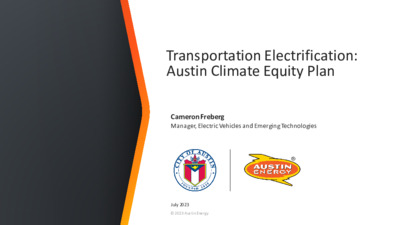3. EV Update - Austin Energy — original pdf
Backup

Transportation Electrification: Austin Climate Equity Plan Cameron Freberg Manager, Electric Vehicles and Emerging Technologies July 2023 © 2023 Austin Energy Supporting the Community-Led Transition to Electric Transportation Strategy 1: Conduct an EV Community Needs Assessment Strategy 2: Create equitable incentives for buying and leasing EVs Strategy 3: Reduce tolls for EVs in the Eastern Crescent Strategy 4: Launch an e-bike and electric car-sharing program Strategy 5: Electrify public sector fleet vehicles Strategy 6: Electrify private sector fleet vehicles Strategy 1: Create a regional coalition to support EVs Strategy 2: Pilot and adopt new technology Strategy 3: Prioritize a just transition Strategy 4: Expand the EV-related business ecosystem Strategy 1: Create a network with more low-cost, accessible charging stations Strategy 2: Incentivize internet-connected smart charging Strategy 3: Adopt new energy and building codes Strategy 4: Expand outreach to systematically excluded groups 2 Recommended Discussion Points: Emissions impact: What sub-strategies and related actions have been identified by the City as having the highest emissions reduction potential? Equity impact: What sub-strategies and related actions have been identified by the City as having the highest potential for positive equity impacts? Low-hanging fruit: What are the low-hanging fruit for both? What are some of the actions that have been identified by the City, Austin Energy, CapMetro, external partners, or other stakeholders? Barriers and challenges: Which sub-strategies and actions face the greatest barriers? What are those barriers or challenges specifically? 3 Strong Electric Vehicle Growth in Austin Moving the needle on transportation emissions 35,000+ EVs in the Austin Metro Area Source: EPRI Analysis of Experion Data 4 Austin Energy’s 5-Pillar Transportation Electrification Strategy Charging Infrastructure Equity & Affordability Fleets & New Mobility Outreach & Education Grid Integration 5 Charging Infrastructure Plug-In Austin Infrastructure Rebate Program For home and public stations Plug-In EVerywhere™ Driver Program Access to over 1500 Level 2 ports DC Fast Charging 30 stations in network 6 Equity & Affordability E-Bike Rebate & MetroBike Expansion • Rebate doubled on January 1, 2023 • Increased rebate ($1,300) for CAP customers EVs for Schools Program Educational Living Lab including charging infrastructure and curriculum at local schools 7 Fleets & New Mobility Powering the City's Fleet • Now 275 EVs (and growing) • Savings tracking 50% ahead of projection • New “Quick-Turnaround” EV charging station permitting process Bus Electrification • Capital Metro • Fleet and Infrastructure Rate Developed 8 Outreach & Education EV Buyers Guide Electrify Expo EVs for Schools EV.AustinEnergy.com • Real-time local inventory • New and used EVs • English and Spanish Experiencing Electric Mobility • 13,411 Attendees • 4,232 In-vehicle EV demos • 10,695 Micro-mobility demos total: • 7,338 E-bike demo rides • 1,265 E-scooter and E-skate • 2,092 Kids Zone demo rides Mentoring Future Leaders "I received excellent feedback from the students, and they were excited about possible career opportunities associated with renewables!" – Akins STEM Engineering Teacher 9 EV Grid Integration Managed Charging • EV360 – Residential off-peak pilot • Power Partner demand response program – active charge management • Vehicle to Grid pilot – part of larger energy storage project 10 Highest Emissions Reduction Potential Strategy 5: Electrify public sector fleet vehicles Strategy 6: Electrify private sector fleet vehicles Strategy 1: Create a network with more low-cost, accessible charging stations Strategy 2: Incentivize internet-connected smart charging 11 Highest Equity Impact Potential Strategy 1: Conduct an EV Community Needs Assessment Strategy 4: Launch an e-bike and electric car-sharing program Strategy 4: Expand outreach to systematically excluded groups 12 Barriers & Challenges Strategy 1: Conduct an EV Community Needs Assessment Strategy 3: Reduce tolls for EVs in the Eastern Crescent Strategy 4: Expand the EV-related business ecosystem • Scoping a needs assessment • Responsible entity of reducing tolls? • Defining success for business ecosystem growth? 13 Community and Engagement • TX Electric Transportation Alliance Collaboration = Success Education Government • Austin Independent School District • City of Austin • Austin Forum on Technology & Society • Pflugerville Independent School District • Housing Authority of the City of Austin • Foundation Communities • Austin Pathways/Smart Mobility Ambassadors • American Public Power Association • Del Valle ISD • EcoRise • Travis County • Congressman Lloyd Doggett’s Office • Huston-Tillotson University • CapMetro • University of Texas LBJ School of Public • Texas Commission on Environmental • TX Public Power Association Affairs Quality • TX Energy Poverty Research Institute • Bike Texas • US Department of Energy • Austin Auto Dealership Association • Austin Community College • Local E-Bike retailers 14 ©2023 Austin Energy. All rights reserved. Austin Energy and the Austin Energy logo and combinations thereof are trademarks of Austin Energy, the electric department of the City of Austin, Texas. Other names are for informational purposes only and may be trademarks of their respective owners. The picture can't be displayed. Strategy 1: Conduct an EV Community Needs Assessment Strategy 2: Create equitable incentives for buying and leasing EVs Strategy 3: Reduce tolls for EVs in the Eastern Crescent Strategy 4: Launch an e-bike and electric car-sharing program Strategy 5: Electrify public sector fleet vehicles Strategy 6: Electrify private sector fleet vehicles 16 Strategy 1: Create a network with more low-cost, accessible charging stations Strategy 2: Incentivize internet-connected smart charging Strategy 3: Adopt new energy and building codes Strategy 4: Expand outreach to systematically excluded groups 17 Strategy 1: Create a regional coalition to support EVs Strategy 2: Pilot and adopt new technology Strategy 3: Prioritize a just transition Strategy 4: Expand the EV-related business ecosystem 18